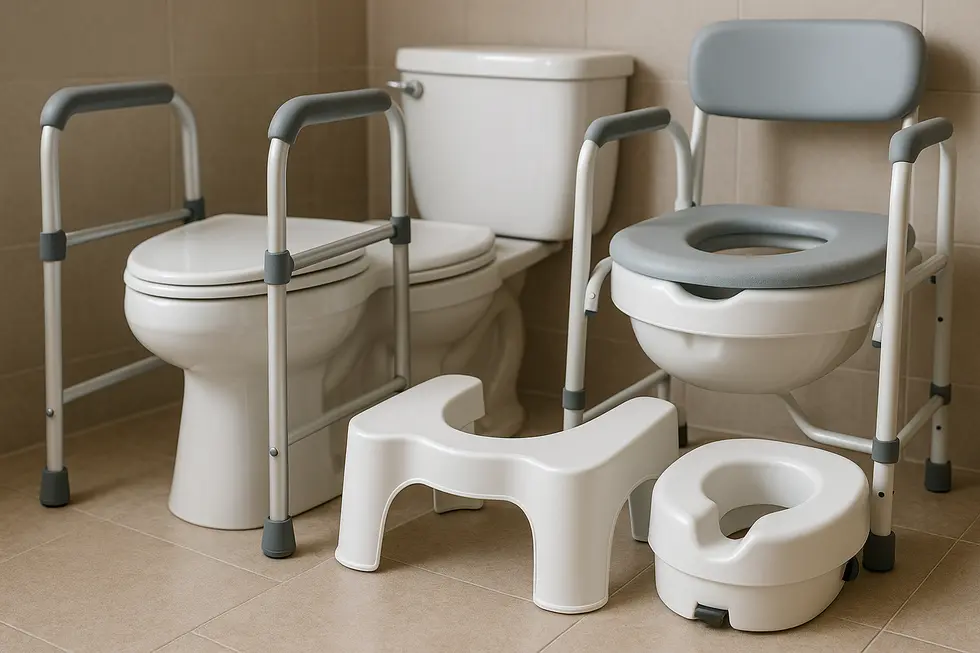Toilet Stools
Essential Toilet Stools for Elderly: Boosting Safety and Independence
Navigating daily activities can become increasingly difficult as individuals age, especially regarding essential tasks like toileting. Investing in the right toilet stool can drastically improve safety, comfort, and independence for elderly family members, making it a crucial consideration. From design nuances and market trends to safety guidelines, this comprehensive guide delves into how toilet stools are transforming the experience of elder care. Discover the innovative designs tailored to meet varying needs, the growing market for these indispensable aids, and the safety measures to prevent falls and enhance usability.
From Height to Handrails: Designing Toilet Stools that Truly Serve Older Adults

Balancing security and dignity in the bathroom begins with thoughtful design. A well-made toilet stool for seniors addresses three inseparable needs—easier transfers, joint relief, and dependable stability—without turning the room into a miniature clinic.
Elevating without Overstretching
Most older adults struggle during the final inches of sitting and the first inches of rising. An elevated seat—ideally 17–21 inches from floor to rim—places the hips level with or slightly above the knees, so the movement mimics getting up from a dining chair rather than a low bench. This small change cuts knee stress and can reduce assistance calls after surgery or in arthritic flare-ups. Stools that slide securely over an existing bowl, or commode frames that double as bedside chairs, both meet this height target; choosing between them depends on whether portability or a fixed, one-piece look is preferred.
Supporting the Whole Body, Not Just the Posterior
Padding matters. High-density, closed-cell cushions distribute weight and keep pressure sores at bay during longer bathroom visits common with constipation management. Equally important are armrests that curve slightly forward; this geometry lets users lever themselves up without tilting their center of gravity dangerously backward. Anti-slip feet—rubber or textured thermoplastic—anchor the base even on glossy tiles. When combined, these features create a stable four-point system: feet on the floor, hands on the arms, body on the pad.
Design Details that Simplify Care
Smooth, non-porous plastics resist staining and wipe clean in seconds, crucial when caregivers juggle multiple tasks. Wide openings allow easy use of handheld bidets or integrated wash systems, promoting hygiene while reducing paper reach and twist. For families comparing models, a quick review of safety and comfort guidelines for elderly toilet stools can clarify which features matter most for a given diagnosis.
Future-Proofing the Choice
Look for adjustable legs or interchangeable risers so the same stool adapts if mobility declines. Odor-seal lids, though optional, preserve discretion in shared households. Ultimately, the best design is the one an older adult can use confidently every single time—free from slips, unnecessary strain, and the worry of calling for help.
For a practical overview of raised seat variations and sizing tips, visit this external resource: overview of raised toilet seat options.
Silver Age, Strong Demand: Economic Forces Shaping Elder-Friendly Toilet Stools

The toilet stool may look like a modest accessory, yet global economics tell a different story. Behind each molded piece of polypropylene stands a powerful demographic surge. By 2030, one in six people worldwide will be over 60, and the cohort will swell past two billion by mid-century. This silver tsunami is already driving a multi-billion-dollar assistive-device industry, and bathroom safety products sit squarely in its wake.
North America currently commands the largest share because higher health-care spending quickly converts clinical advice into household purchases. Public insurance programs frequently reimburse durable medical equipment, so a raised or ergonomic stool moves from “nice to have” to “prescribed necessity.” Meanwhile, Asia-Pacific’s growth curve is steeper. Populous nations are racing to retrofit homes for aging parents, and rising disposable incomes shorten the leap from awareness to acquisition.
Investment analysts often group toilet stools under patient-handling equipment or traditional toilet seat accessories. The figures are still compelling: segments that ease transfers or improve posture post five-to-six-percent compound annual growth, tracking the momentum of obesity and arthritis rates. Commercial demand compounds the effect. Long-term-care centers and senior housing projects standardize fall-prevention fixtures during construction, creating bulk orders that ripple through supply chains.
Technology is another accelerant. Lightweight polymers lower shipping costs, integrated hand-grips add perceived value, and antimicrobial coatings answer infection-control protocols. Digital features—pressure sensors that flag prolonged sitting or Bluetooth modules that remind caregivers—are already in prototype stages. Such innovation supports premium pricing and widens manufacturer margins.
Policy initiatives reinforce the trend. Many governments fund home-modification grants; others cut import duties on certified assistive goods. When reimbursement and tax incentives align, purchasing barriers collapse, especially for fixed-income seniors.
For consumers, these macro forces translate into broader choice. Adjustable heights, fold-away designs, and even aesthetic finishes once reserved for luxury bathrooms are filtering into mainstream catalogs. If cost-benefit still needs framing, consider the health-system savings every avoided hip fracture represents—a point explored further in our review of the economic advantages of adjustable toilet stools.
In short, elder-friendly toilet stools ride the same currents lifting the wider assistive-device fleet: unprecedented aging, chronic disease prevalence, and supportive policy. Analysts forecast the sector to mirror the larger assistive-device market’s climb toward USD 52 billion by 2034, underscoring that this humble bathroom aid now plays on a global, growth-driven stage. External Source
From Foot Placement to Lighting: Practical Fall-Proofing When Adding a Toilet Stool for Seniors

A toilet stool can transform toileting from a wobbly, painful task into a confident routine, yet only when the surrounding environment supports safe movement. The first safeguard is choosing the correct rise. Most older adults need no more than a 2–4-inch lift; taller models may tip balance forward, encouraging falls rather than preventing them. Equally critical is stability: a broad, rubber-tipped base that grips tile or vinyl stops the device from skidding when weight shifts.
Once the right model arrives, placement matters. Slide the stool until its rear edge nestles the toilet’s base so both feet land squarely. Lock any height pins and test for rocking before inviting the user to try. At this moment, think beyond the stool itself. Dual grab bars—either wall-mounted or part of a clamp-on frame—give the hands a predictable anchor. Position them where elbows stay at roughly 45 degrees; bars that are too high force a shoulder shrug, too low encourage forward lurching.
Lighting completes the tripod of safety. A battery-powered night-light that kicks on with motion guides sleepy eyes along a clear, rug-free path. During daytime, remove decorative mats and scale back clutter; even a lightweight wastebasket can redirect a walker tip and trigger a stumble. Encourage non-skid slippers with closed backs to further seal the floor-foot connection.
Technique drills are surprisingly powerful. Teach users to plant both feet on the stool, hinge at the hips, and sit slowly while eyes stay forward—looking down often shifts weight suddenly. Rising follows the mantra “nose over toes,” pressing through legs rather than yanking on armrests. Caregivers should spot the first sessions, ready with a gait belt instead of pulling on fragile wrists. Schedule a monthly five-minute equipment check: wipe moisture, tighten bolts, and inspect rubber feet for glazing. After any hospitalization or new medication, ask a physical therapist to reassess the set-up.
These small, disciplined steps knit together to lower fall risk while preserving dignity—an outcome explored further in this detailed safety and comfort guide. For a broader home-wide checklist, consult the National Institute on Aging’s resource on aging-in-place safety.
Final thoughts
Toilet stools for the elderly are pivotal in maintaining safety, comfort, and independence in daily life. By understanding their design features and appreciating the market dynamics that support their development, we can make informed choices that enhance the quality of care for seniors. Prioritizing safety guidelines and integrating these stools with comprehensive bathroom safety strategies ensures a safer, more accessible environment for our aging loved ones.
Experience a new standard of clean with PEGABidet—designed for comfort, safety, and independence. Join thousands who trust us to make personal care simple and dignified. Contact us at contact@pegabidet.com
About us
PEGABidet is a brand owned by L.A NEXTGEN LLC, based in California. We design intuitive, hygienic, and accessible bathroom solutions that prioritize safety, dignity, and independence. Our mission is to make personal care effortless and empowering for people at every stage of life.

